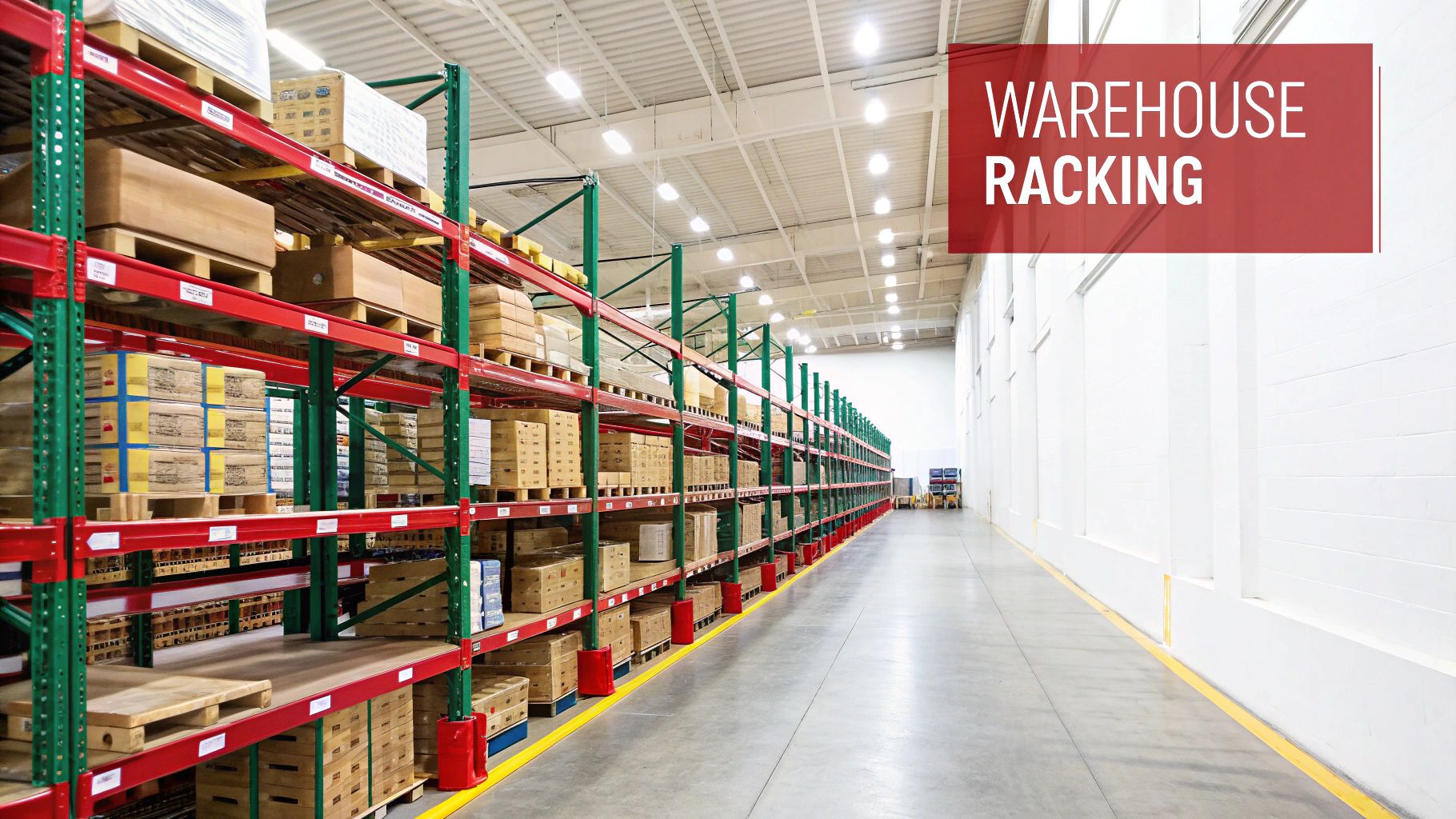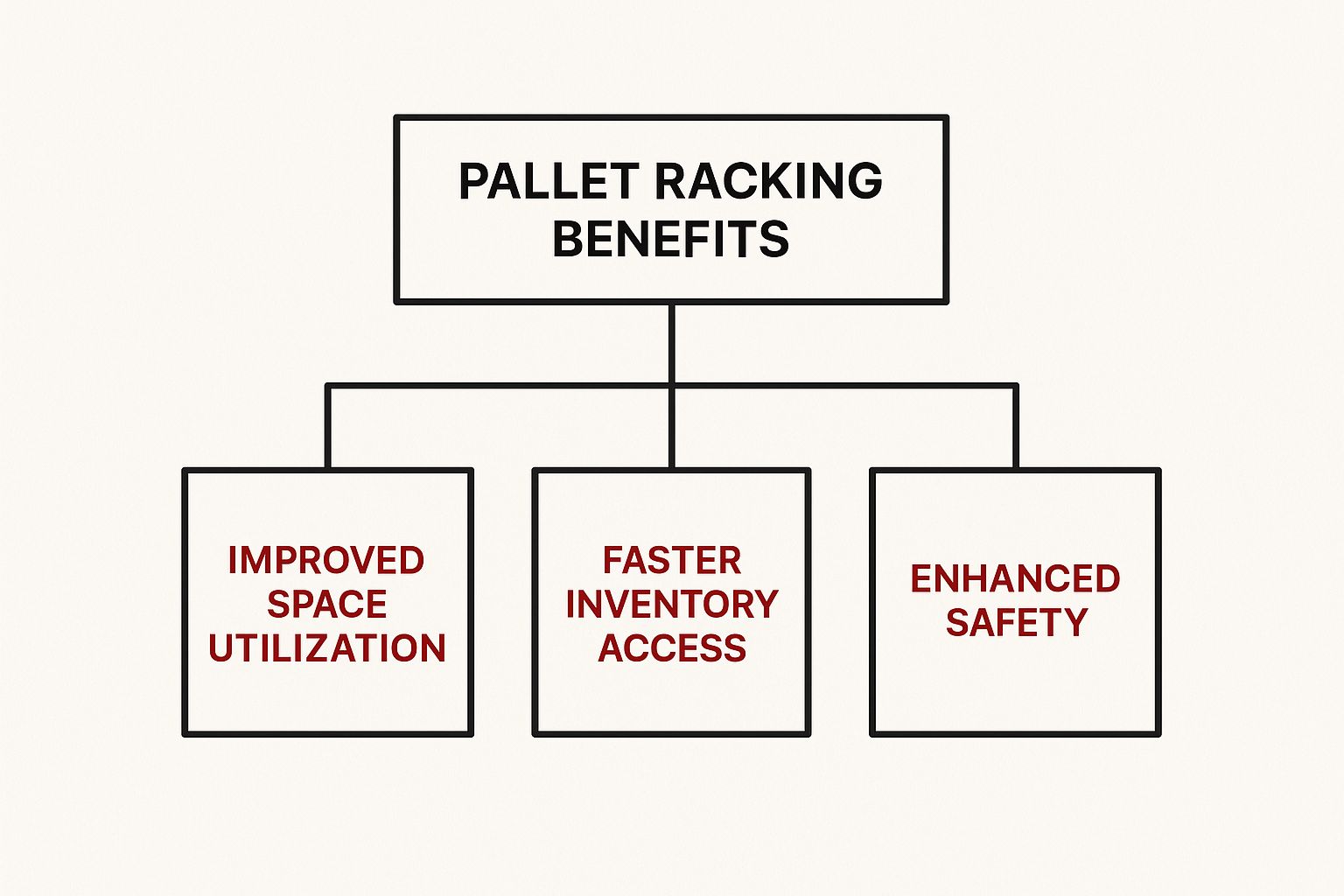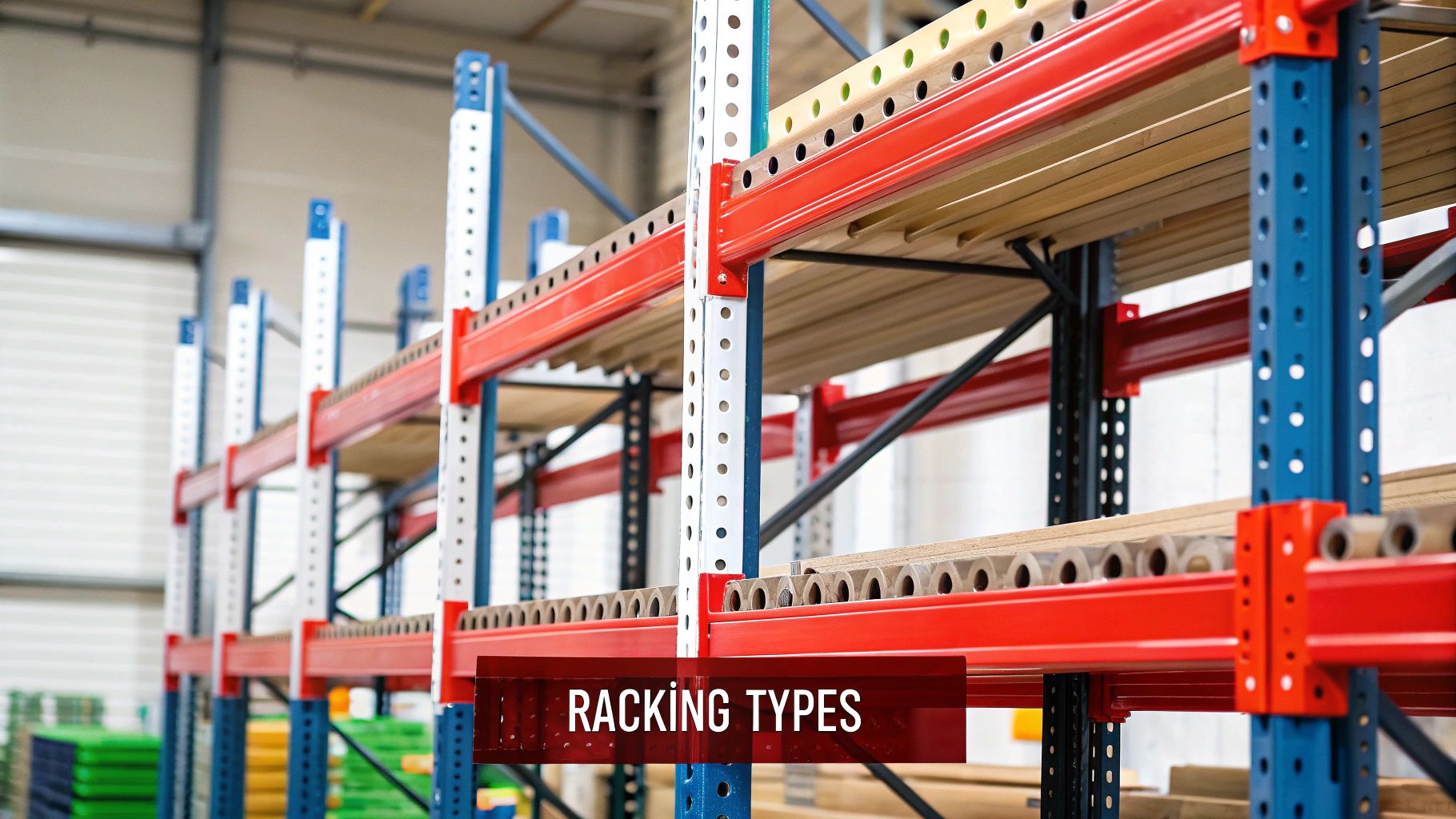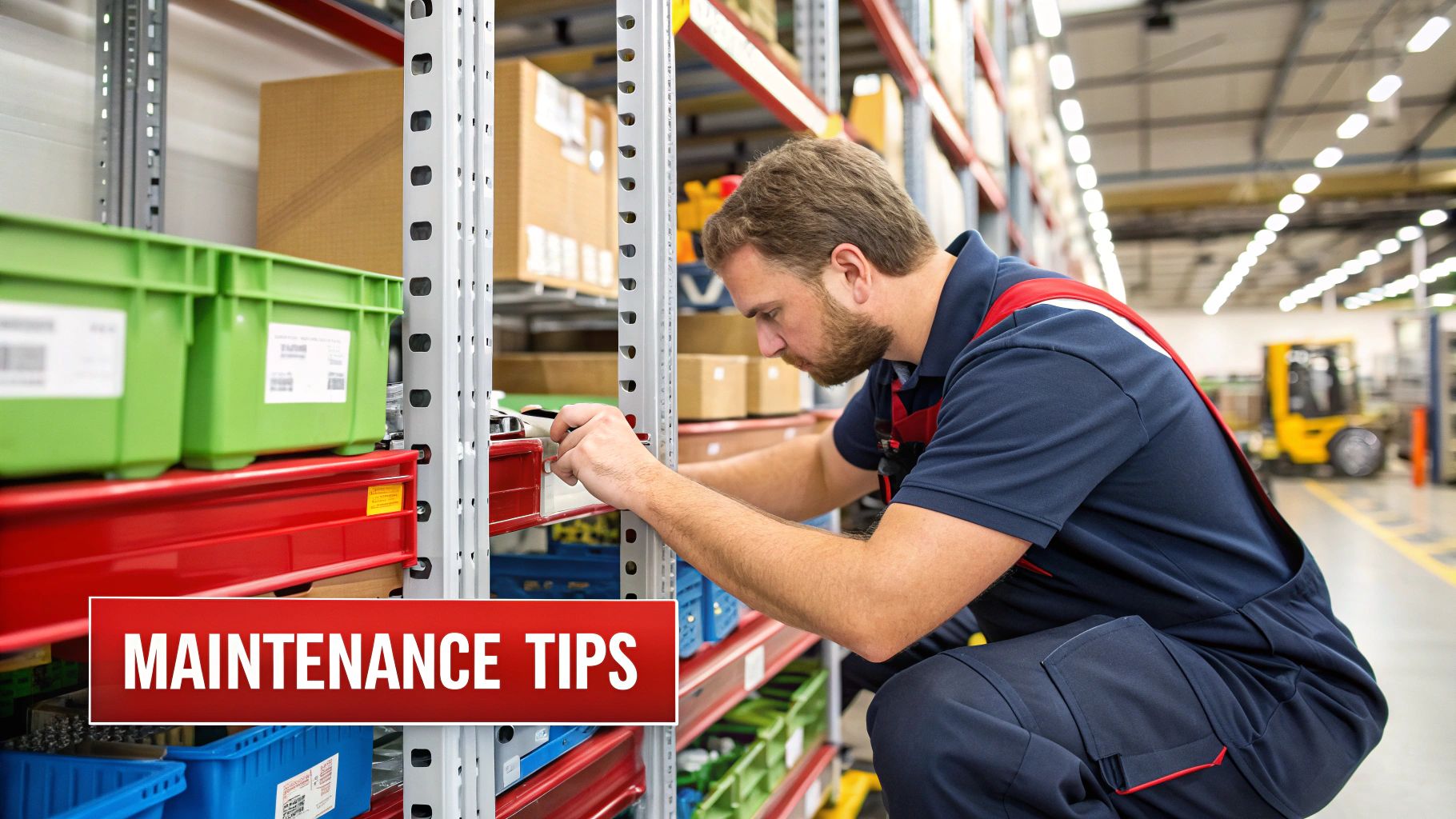Pallet warehouse racking is the steel framework that lets you store palletised goods in horizontal rows, stacked multiple levels high. It’s hands down the single most effective way to turn empty vertical space into valuable, usable storage, completely changing how Aussie businesses organise their warehouses and run their day-to-day operations.

Don’t just think of pallet racking as simple steel shelving. It’s the skeleton that gives your entire storage operation its structure and strength. Think about the difference between a garage with boxes piled on the floor versus one with a sturdy, organised shelving system. Pallet racking does the exact same thing, just on a much bigger, commercial scale.
For any Australian business in logistics, manufacturing, or e-commerce, a good racking system isn’t just nice to have—it’s essential. It directly affects how fast you can find, move, and ship your products, which in turn impacts customer satisfaction and your bottom line. A well-designed system isn’t just about holding stock; it’s about creating a smarter, safer, and more productive workflow.
Investing in high-quality, properly engineered racking is one of the smartest moves a warehouse manager can make. It’s the difference between a chaotic, inefficient space and a streamlined, profitable one. The benefits go way beyond just getting your stock off the floor.
A well-planned pallet racking solution delivers some serious advantages:
At its core, pallet warehouse racking is an investment in efficiency. It turns unused air into a valuable asset, creating a direct path to better inventory control, faster fulfilment, and a safer workplace.
Choosing the right partner is just as important as choosing the right system. At Super Rack, we offer superior quality pallet racking at competitive prices, backed by fast, nationwide delivery across Australia. Our team provides expert advice to ensure you get a solution that perfectly fits your needs, helping you build a warehouse that is both productive and safe from the ground up.
Walking into the world of pallet racking can feel a bit overwhelming, but it really boils down to one thing: matching the system to your inventory and workflow. Different types of pallet racking solve different problems. Getting this choice right is the key to creating a truly efficient and productive space.
Let’s break down the most common types you’ll find in Australia. We’ll cover the versatile all-rounder, the high-density champion, and a few specialised solutions for unique stock, helping you make a confident choice for your operation.
When you picture pallet racking, you’re most likely thinking of selective racking. It’s the most common and straightforward type used in Australia, and for good reason—it gives you direct access to every single pallet, making it incredibly flexible.
Imagine a library where every book is visible and easy to reach. That’s the principle behind selective racking. This 100% accessibility makes it perfect for warehouses that store a wide variety of products (SKUs), especially those with low turnover for each item. If your inventory is diverse and you need to pick individual items or pallets frequently, this system is your go-to.
Best for:
While it offers the best accessibility, it does need more aisle space than other systems, making it less space-dense. But for many operations, its simplicity, lower upfront cost, and flexibility make it an unbeatable choice.
If maximising every last cubic metre is your number one priority, then Drive-In Racking is the system for you. This setup creates incredibly dense storage by letting forklifts drive directly into the racking structure to place or retrieve pallets.
Think of it as a parking garage for pallets. Instead of aisles between every row, you get deep storage lanes that can boost your storage capacity by up to 75% compared to selective racking. It’s the perfect solution for businesses storing huge quantities of identical products.
This system operates on a “Last-In, First-Out” (LIFO) inventory basis, meaning the last pallet you put in a lane will be the first one you take out.
Best for:
The trade-off for this incredible density is selectivity. You can’t get to the pallets at the back of a lane without first clearing out the ones in front.
The following image shows how the right racking system is more than just storage—it’s a cornerstone of an efficient warehouse.

It highlights how a well-chosen system directly builds a more organised, productive, and safer working environment.
So, what if you need more density than selective racking but more accessibility than a drive-in system? Double Deep Racking hits that sweet spot right in the middle. It’s pretty straightforward: you place one row of selective racking behind another, doubling your storage depth.
This setup lets you store two pallets deep from a single aisle, giving your storage density an immediate boost. The only catch is that you’ll need a specialised forklift with a telescopic or pantograph reach mechanism to get to that rear pallet.
Double Deep Racking offers a practical balance, increasing storage density by up to 50% over selective racking while keeping stock reasonably accessible. It’s a clever way to gain capacity without completely sacrificing selectivity.
Best for:
Not everything fits neatly on a standard pallet. For businesses dealing with long, awkward, or bulky items like timber, pipes, or furniture, Cantilever Racking is the only way to go. This system uses strong vertical columns with horizontal arms extending outwards to hold the load.
There are no front uprights getting in the way, which gives you clear, unobstructed access for items of all different lengths.
Best for:
To see the full range of options for these and other systems, you can explore our detailed guide to industrial pallet racking.
Picking the right pallet warehouse racking system is a massive step, but the job’s only half done. Now comes the critical part: designing a layout that squeezes every bit of value from your floor space while keeping your team safe and your operation humming. A smart layout is what separates a truly productive warehouse from one bogged down by bottlenecks.
It all starts with the basics. Get out the measuring tape. You’ll need precise measurements of your total floor area, the clear height under your ceiling (don’t forget to account for lights and sprinklers), and the exact location of any obstacles like support columns, doorways, or fire safety gear. These numbers are the foundation for everything else.
For those fitting out a new space from a bare shell, getting across the details of tenant finish projects is essential. It ensures your pallet racking integrates smoothly into the bigger picture, saving you from expensive changes down the track.

A great layout isn’t just about cramming in as many racks as possible. It’s about creating a logical path for your inventory. You need to map out how goods will move through your facility, from the moment they land at receiving to the second they’re dispatched. We call this workflow analysis.
Think of your warehouse like a production line. Raw materials (your incoming stock) arrive at one end, go through a process (storage and picking), and come out the other side as a finished product (a shipped order). Your pallet racking layout has to support this journey without a hitch.
Here are a few questions to get you started:
A logical flow stops forklifts from playing chicken in the aisles, which doesn’t just speed things up; it makes the whole place safer.
One of the most common—and costly—mistakes we see in warehouse design is getting the aisle width wrong. Your aisles must be wide enough for your material handling equipment, especially your forklifts, to operate safely and without restriction. An aisle that’s too tight is a disaster waiting to happen, leading to damaged racks, ruined products, and serious safety risks.
Every forklift has a specific minimum turning radius, which you can find on its spec sheet. This is the absolute tightest space it needs to make a turn, like when moving from an aisle into a racking bay.
As a rule of thumb, always add a buffer of at least 300mm to the forklift’s minimum turning radius when planning your aisles. This gives operators a bit of breathing room, improving safety and reducing the chance of accidental bumps.
For example, if a standard counterbalance forklift needs 3.7 metres to turn, you should be planning for aisles that are at least 4 metres wide. That small addition makes a huge difference for your drivers and the lifespan of your racking.
Understanding load capacity is non-negotiable. Every single beam and upright in your pallet racking system is engineered to hold a very specific maximum weight. Overloading them is one of the fastest ways to cause a catastrophic collapse. Always, always make sure the system you choose can comfortably handle your heaviest pallets.
The demand for solid storage is only growing, with Australia’s e-commerce and logistics boom driving the market. Mid-capacity pallet racks, rated for 5-15 tons, have become a popular choice, making up around 25-31% of the market because they offer a great balance of strength and cost.
Finally, think about tomorrow. Your business is going to grow, so your layout needs to be able to grow with it. Plan for future expansion by choosing modular racking systems or simply leaving some designated floor space free for additional bays. A little bit of forward-thinking today can save you from a complete and expensive overhaul in a few years.
Your pallet racking is a huge long-term investment, so its performance hinges on three things: correct installation, proactive maintenance, and an iron-clad commitment to safety. Get these right, and your system will remain a safe, reliable asset for years to come.

It all starts with a professional build. Pallet racking is a precision-engineered structure, not just a big set of shelves. Trying to DIY the installation is a recipe for disaster—think misaligned parts, poor anchoring, and a wobbly, unsafe system. Honestly, using a professional service is non-negotiable for structural integrity and compliance from day one.
At Super Rack, we get how critical this is. Our expert teams offer fast, nationwide service to make sure your system is set up correctly and safely right from the start. To get a feel for what’s involved, you can learn more about our professional pallet racking installation services.
Once your racking is up, it needs regular attention to stay in top shape. A proactive maintenance routine is your best defence against small issues snowballing into major hazards. The whole point is to spot and fix problems before they compromise the safety of your people and your stock.
Your routine should be built around regular, documented inspections. This doesn’t need to be complicated. It can be as simple as having supervisors walk the aisles weekly, keeping an eye out for common signs of damage or wear and tear.
Here are the key things to look for during inspections:
Keeping your warehouse safe isn’t just good business—it’s a legal requirement. Australian safety standards lay out clear guidelines for operating pallet racking systems safely and effectively.
A massive part of this is making sure everyone knows the system’s limits.
Every single racking bay must have clearly visible Safe Working Load (SWL) signage. These signs need to state the maximum weight capacity per beam level and for the entire bay. This is a non-negotiable part of warehouse safety.
Beyond signage, a safe environment comes down to a few key practices:
Even with the best maintenance plan, unexpected equipment failures can still happen. Looking into a guide on equipment breakdown insurance can help protect your investment from unexpected downtime and keep your safety standards high.
Ultimately, prevention is always the best strategy for a safe, compliant workplace. It all starts by investing in high-quality, new racking from a trusted supplier like Super Rack, where our commitment to superior quality and competitive pricing gives you the best possible foundation for a safe and efficient operation.
When you’re budgeting for a new pallet racking system, it’s easy to focus on the upfront price of the steel. But that’s only part of the story. The smartest way to approach it is as a long-term investment in your warehouse’s core efficiency, one that needs to pay dividends for years.
The initial quote is just a starting point. To make a decision that benefits your business down the track, you need to understand the full financial picture. It’s not about finding the cheapest option—it’s about securing the best value and lowest risk over the system’s entire life.
The final dollar figure for your pallet racking is influenced by a handful of key variables. Each one directly impacts the system’s strength, capacity, and suitability for your specific operation.
These are the main cost drivers you’ll encounter:
Beyond the hardware itself, you also need to budget for things like nationwide delivery and, crucially, professional installation. These aren’t just “add-ons”; they’re essential to ensure your system is safe, compliant, and built to last.
A tempting low price can often mask future headaches and expenses. This is where the idea of Total Cost of Ownership (TCO) becomes so important. TCO looks past the initial purchase price to include every cost you’ll face over the racking’s lifespan.
Investing in a superior quality system from a reputable supplier like Super Rack from the outset significantly reduces long-term expenses. Cheaper, less durable options might save a few dollars upfront but can lead to frequent repairs, replacement parts, and costly operational downtime.
This long-term view is more critical than ever as warehouse costs continue to climb. For example, in the first quarter of 2025, national median pallet storage rates jumped by about 13% from the previous quarter, driven by rising operational expenses and inventory levels. This trend, highlighted in this 3PL market roundup, puts immense financial pressure on warehouses, making efficient and reliable infrastructure a non-negotiable.
Choosing a high-quality pallet racking system is a forward-thinking move that strengthens the core of your warehouse. It means fewer disruptions from damaged parts and a much safer environment for your team. Plus, routine maintenance, like following a proper pallet rack inspection schedule, becomes far simpler and less expensive with a well-made system.
Ultimately, the goal is to get the best possible return on your investment without ever compromising on safety or quality. By focusing on the total cost of ownership, you ensure your pallet racking becomes a durable, reliable asset that supports your business for the long haul. At Super Rack, our commitment to superior quality at competitive prices means you get the best value right from day one.
When you’re fitting out a warehouse, questions are bound to pop up. Investing in a new pallet warehouse racking system is a big call, so it’s smart to get clear, practical answers before you commit. Here are some of the most common queries we get from Aussie business owners.
Think of this as your cheat sheet for understanding the essentials, from calculating loads to your legal duties for inspections. It’s all about giving you the confidence to make the right choice for your operation.
Getting the load capacity right isn’t just important—it’s a critical safety measure. The first step is to know the maximum weight of your heaviest loaded pallet. Simple enough. From there, you just multiply that weight by the number of pallets you plan to store on a single beam level.
The beam’s own rated capacity must always be higher than that total figure. Don’t forget the upright frames either; they need to support the combined weight of all the beam levels stacked above them. In Australia, it’s also a legal requirement to have clear Safe Working Load (SWL) signs displayed on your racking. We always recommend chatting with a racking expert to ensure your system is properly engineered for your specific loads.
The go-to pallet size across Australia is 1165mm x 1165mm. The vast majority of pallet racking systems you’ll find locally are designed to fit these dimensions perfectly, which means your goods will have a secure and stable base.
Sure, you might come across other types like the smaller Euro pallets, but for domestic logistics, planning your layout around the standard Aussie pallet is easily the most practical way to go. Just be sure to confirm your primary pallet dimensions during the design phase to lock in the ideal beam lengths and frame depths for your setup.
Yes. Absolutely. Think of pallet racking as an engineered structural system, not just a big set of shelves you can knock together yourself. Professional installers are trained to assemble it exactly to the manufacturer’s specs, making sure every component is perfectly level and securely anchored to the concrete floor.
This isn’t a step you want to skip—it’s about protecting your people and your valuable stock. A DIY or incorrect installation can easily lead to a catastrophic collapse, and that’s a risk no business should ever take. Using a certified service, like the one offered by Super Rack, guarantees your setup complies with Australian safety standards and gives you total peace of mind.
Regular inspections are the backbone of a safe warehouse. It’s a great habit to get your team into doing daily or weekly visual checks for any obvious damage—things like dents in the uprights or bent beams from a forklift knock.
On top of these informal checks, Australian standards mandate a full, comprehensive inspection by a qualified person at least once every 12 months. This formal inspection needs to be properly documented. If any damage is found, it must be repaired or replaced immediately to stop a minor issue from becoming a major hazard.
Ready to build a safer, more efficient warehouse? The expert team at Super Rack is here to help. We offer superior quality pallet racking systems with fast, nationwide delivery across Australia. Get in touch with us today for practical advice and a competitive quote. Visit us at https://www.superrack.com.au to learn more.
4000 to 4182
4186 to 4207
4300 to 4305
3000 To 3096
3098 To 3112
3114 To 3138
3140 To 3157
3161 To 3198
3200 To 3207
Order Delays for Temporary Fencing, Agricultural Products, Pallet Racking, Cantilever Racking and Mesh Panels
Let's connect